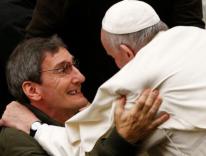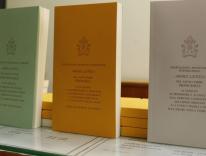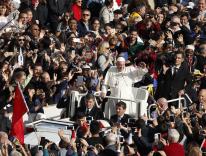The annual conventions of America’s theologians and scholars of religion are great opportunities for non-American academics (like me) to get a sense of what’s happening in the field. Yes, the old country has its European Society for Catholic Theology (founded in 1989), but it can’t yet aspire to be a hub of important activity like the Catholic Theological Society of America, the College Theology Society, or the American Academy of Religion (AAR).
Case in point: catching my attention at the recent AAR annual convention in Atlanta were the translations from French into English of the private journals of two of the most important Catholic theologians in the 20th century, whose work was decisive in the theological developments of Vatican II: Yves Congar and M.D. Chenu. Congar’s journal of the council is already known to the English-speaking audience (it was translated and published in 2012), but here we have now an even more dramatic and personal diary: Journal of a Theologian 1946-1956. Here is an excerpt from the section devoted to the dramatic weeks in the summer of 1950, when Pius XII’s encyclical Humani generis (bearing the date August 12) was used to silence scores of Catholic theologians, Congar included.
Paris, eleven o’clock in the morning, 17 August 1950. Fr General [Manuel Suarez, 1946-1954] arrived in Paris on the evening of the 16th and asked for me to see him this Thursday morning, the 17th. He received me from 9:15 to 10:15 and I am making a note immediately of the essence of what he said to me. Actually, he repeated certain things several times and dwelt on some points. Essentially, it is to do with Chrétiens désunis [Congar’s seminal book on ecumenism, published in 1937, translated into English and published in 1939 with the title Divided Christendom]. Certain newspapers have announced that a new edition had been banned by the Holy Office. … [Fr. General tells me] I would need to revise Chrétiens désunis in the light of the text of the Holy Office; I would need to correct certain things. I was not told that. … He wants me to make changes myself; he does not want Rome to be involved in any way… . Fr. General told me that it would be necessary to do something to regain the trust of Rome. Every time he mentions my name it is brushed aside for some reason… Very often, people are surprised that I am still teaching… I told him that I believe that it is impossible that I shall ever regain the trust of Rome. That surprised him and even shocked him a little. But I told him: Fr. Lacordaire never got to clear his name, nor did Fr. Sertillanges… Once one has been pigeonholed one can never be restored. He told me that the pope had said to him, a little before the death of Sertillanges, that he was one of his admirers… But that did not stop Fr. Sertillanges having difficulties right up to the end.
No less interesting is the Vatican II Notebook from Chenu. It is one of the many council journals that end with the first session of Vatican II. Two days before the opening of the council on October 11, 1962—when John XXIII delivered his speech Gaudet mater ecclesia, redefining the agenda of Vatican II—Chenu reported his conversation with Cardinal Léger of Montreal about the documents drafted during the preparatory phase of the council:
[Léger] spoke to me with excitement about his disappointment with the doctrinal schemas: speculative theses that only repeat Vatican I and don’t consider the needs and possibilities of our time. We aren’t any longer at the time of the doctrinal liberalism of 1860, nor of anti-ecclesiastical socialism. We aren’t in a ghetto either. We can’t be content to throw stones at the communists, telling me of something that John XXIII said to him. The Americans are still at the Council of Trent. ‘Myself’, he said, ‘I have become compromised—my opponents call me “the furious cardinal.”
Three days later, in his note of October 12, Chenu reports what Henri de Lubac tells him about the status of “the Rahner affair,” which arose out of the Holy Office’s request in June 1962 to subject Karl Rahner’s writings to preliminary scrutiny by a Roman censor, a request that German bishops went to John XXIII to appeal. “The Rahner affair is over,” Chenu writes. “Faced with clear support from the German bishops, the Holy Office pulled back; so as not to lose face, they did not reverse their judgment, but they delegated the power of imprimatur to Cardinals König and Döpfner, the defenders of Fr. Rahner!”
It is interesting to know that the Holy Office removed the preliminary censorship against Rahner only in May 1963, after he had been appointed officially a peritus theologian of Vatican II. (De Lubac, who had his own problems with the Holy Office, compiled his accounts in his Vatican Council Notebooks, the first volume of which has recently been published in English.)
The treatment of Congar, Rahner, de Lubac, and many others by the Holy Office (which Congar called “the supreme Gestapo” in his entry of February 9, 1954) tells us how far we are from the culture not only of the church of Pius XII (the quieting—for lack of a better term—of the Congregation for the Doctrine of the Faith by Pope Francis may the nearest example), but also the church of John Paul II and Benedict XVI.
On the other hand, Chenu and Leger’s mention of “the doctrinal liberalism of 1860” reminds us how far we are also from that historical consciousness, which is what makes many of our seminarians and young priests and bishops look at Vatican II as the epitome of a dangerous theological liberalism. What strikes me about the Catholic church of today, especially when considering the debates at the recent synod, is how history (church history, the history of doctrinal developments, the history of institutions like marriage) is used, or, if you will, not used, when making arguments about doctrine. This is unfortunate. Perhaps the globalization of Catholicism has complicated things. But then that’s all the more reason to make time for history. That there’s so much of it is a good thing, and the best way to ensure development of doctrine is to explore its depths.
Please email comments to [email protected] and join the conversation on our Facebook page.
Share
Previous Story
Please Give a Moment to Commonweal on Giving Tuesday
Next Story
Christmas Critics 2015


